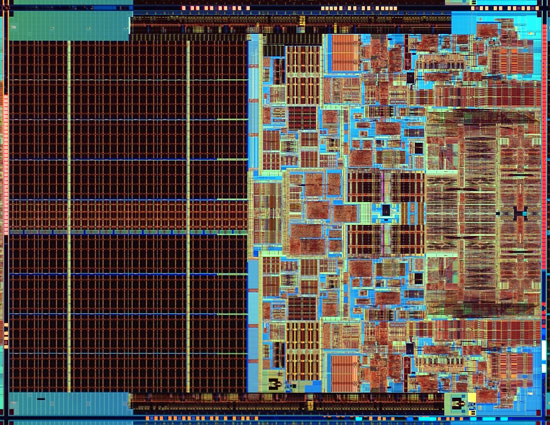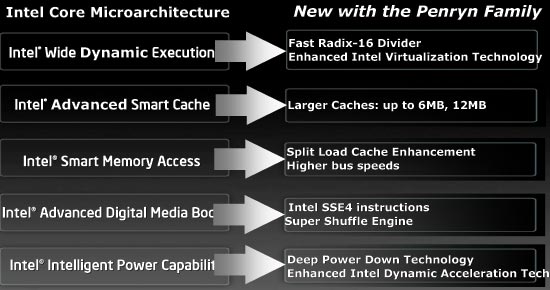The Penryn Preview - Part I: Wolfdale Performance
by Anand Lal Shimpi on August 21, 2007 12:35 PM EST- Posted in
- CPUs
By the end of this year, AMD will introduce Phenom and Intel will introduce Penryn - its first 45nm desktop CPU.
For a while there we wondered how Intel would introduce Penryn into its lineup, but as of Intel's last roadmap update we now know. On top of that, we managed to get our hands on a dual-core Penryn so now we know exactly how fast the new core is going to be. Combine the two datapoints and there's a wealth of knowledge to share. So gather 'round the fire, it's time to benchmark CPUs.
Recapping Penryn
Penryn is more than just a die-shrunk Conroe, but it isn't anywhere near as revolutionary as what Conroe was to its predecessor. The Conroe-Penryn evolution is one cycle of Intel's tick-tock model, Penryn's successor (Nehalem) will be the next revolutionary core you see out of Intel (at least that's what we're expecting).

Penryn is built on Intel's 45nm process, thus dropping power consumption increasing switching speed and allowing Intel to cram more transistors on a die (107mm^2 for dual-core Penryn vs. 143mm^2 for Conroe).

A dual-core Penryn die

A dual-core Conroe die
Intel lists the following 9 enhancements as what's new in the Penryn family:

The faster divider and super shuffle engine will increase performance in very specific applications and won't be broad increasers of performance. The larger caches obviously will increase performance, but prior to today we weren't sure by how much.
SSE4 support can bring about tremendous performance improvements, but it requires software optimization. In our initial Penryn Preview we reported an over 100% increase in performance in SSE4 optimized DivX encoding for a quad-core Penryn at 3.33GHz vs. a quad-core Kentsfield at 2.93GHz.
We detailed all of the Penryn enhancements and the markets they impact in our original Penryn article. Keep in mind that things like Penryn's Deep Power Down Technology and higher bus speeds may not apply to all Penryn cores (the former is only in Mobile Penryn while the latter will appear on servers first).
Never Take Sides Against the Family
Penryn is the overall family name but there are two cores in particular that we'll be talking about today: Wolfdale and Yorkfield.
Wolfdale is a dual-core desktop Penryn core with a 6MB L2 cache shared between the two cores. Yorkfield is two Wolfdales on the same package, giving the quad-core CPU a total of 12MB of L2 cache.
Wolfdale and Yorkfield are architecturally identical, so performance per core is no different between the processors - Yorkfield simply has more cores.










55 Comments
View All Comments
Reynod - Saturday, September 1, 2007 - link
Another great article Anand.Informative and helpful.
I really hope your doing something similar with the new AMD cpu and will wait and see what you write.
Like many people thinking of upgrading I await what AMD will offer after the 10th of Septenber ... but its clear Intel have a range of strong offerings at present.
All we need now is to see what CPU design Nvidia are cooking up ... heh heh.
We might end up with 3 competing complete platform (cpu, chipset, graphics) providers ... ??
Maybe that's why Intel is trying so hard to crush AMD at the moment ... wars on two fronts are much more difficult than one !!
Lord Evermore - Sunday, August 26, 2007 - link
189.1 - 170.3
I don't see a 12.6W power difference in that chart. I see 18.8W. 12.6 isn't even the amount it changed from the idle draw.
At least you got the percentage calculations correct for a decrease (difference/Conroe instead of difference/Penryn).
Lord Evermore - Sunday, August 26, 2007 - link
For that matter, I just noticed the percentage was measured using the correct 18.8W measurement.AnnonymousCoward - Saturday, August 25, 2007 - link
Great review! This is valuable information, to know how Intel's next-year CPUs will perform.Carfax - Saturday, August 25, 2007 - link
Does anyone know what resolution the game benches were run at?These benchmarks vary considerably compared to the HKepc ones, which could be explained if Anandtech ran the benches at a higher resolution compared to HKepc.
AnnonymousCoward - Saturday, August 25, 2007 - link
You're missing the whole point. The two sites aren't necessarily using the same graphics card, other hardware, exact test conditions, same driver, etc. If you want to see framerates, read a regular review on a game or graphics card. Anandtech's benchmark set the resolution very low so that it would be CPU-limited.ShowsOn - Friday, August 24, 2007 - link
I'm wondering if the x264 video encoder could become a new benchmark?There is already a set of benchmark files http://forum.doom9.org/showthread.php?t=122318">herethat provide a consistent encoding task.
Numerous people in the doom9 forums have already run the benchmark, http://img508.imageshack.us/img508/8092/couper12nx...">which has produced the following chart.
It would be fascinating to see how much faster - clock for clock - the penryn cores are on this particular task.
coldpower27 - Thursday, August 23, 2007 - link
I must have missed it by could you tell me what resolutions you used in the gaming tests?Affectionate-Bed-980 - Wednesday, August 22, 2007 - link
I'm sorry but anytime you introduce a new CPU we all expect IN DEPTH articles. No, we don't want a quickie that just touches a few things and a few benchmarks so you can shoot this out the door and say "Hey! I got the first article out!"Sure it may be a preview because the chips aren't officially out yet and these are merely engineering samples.
The biggest complaint was OCing. If you're not going to even do a little minor OC with different voltages, then what the hell is the point of putting a tease up there.
Anyways.. seriously. I expect more detailed articles than this if you're going to review some piece of hot technology...
DarthAgitated - Wednesday, August 22, 2007 - link
My god man.. Did you pay for this article.. Did someone give you a choice to read this article or spend 15 minutes with a model and you chose the article?It's a preview. Of a cpu that's not coming for another couple of months. From a company that usually makes people sign NDA's up the ying yang so you can't report on anything.
Damn them for managing to get a cpu in advance and telling us something about it. And in case you don't know, intel can tell when a cpu is overvolted. But I suppose they should have possibly fried it or hand it back to their mole and let him try and explain to Intel why their cpu was overvolted or fried. Maybe you can tell the people at anandtech how far they can overvolt a new 45nm cpu..
Knowing what a cpu can be overclocked to on standard voltages is kind of a good thing to know. Knowing something about performance is probably a good thing to know. Any info is good info.
Unless it's a press release. Then it's usually useless.
Thanks for being a downer.
me